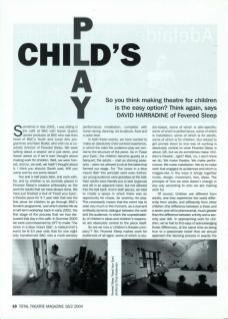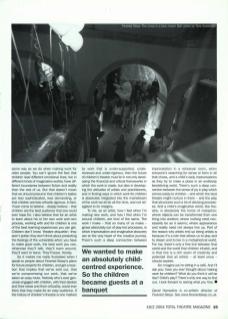Sometime in late 2001, I was sitting in the café at BAC with Sarah Quelch (senior producer at BAC who was then head of BAC's Youth and Local Arts programme) and Sam Butler, who with me is co-artistic director of Fevered Sleep. We were talking about a project we'd just done, and Sarah asked us if we'd ever thought about making work for children. Well, we were honest, and no, we said, we hadn't thought about it. I think you should, Sarah said, Will you come and try out some ideas?
Two and a half years later, and work with, for, and by children is as centrally placed in Fevered Sleep's creative philosophy as the work for adults that we have always done. We have just finished a tour of Feast your Eyes, a theatre piece for 4-7 year-olds that was the first piece for children to go through BAC's Scratch programme, and which started life as a half-term workshop back in early 2002, the first stage of the process that we had discussed that day in the café. In Summer 2003 we were commissioned by LIFT to make The (once in a blue moon) Ball, a midsummer's event for 6-10 year-olds that for one night only transformed BAC into a multi-sensory performance installation, complete with horse-racing, dancing, ice sculpture, food and a polar bear.
In both these events, we have wanted to make an absolutely child-centred experience, in which the roles the audience play are central to the structure of the piece. So in Feast your Eyes, the children became guests at a banquet: the adults – cast as starving peasants – were not allowed to sit at the table that formed our stage. For The (once in a blue moon) Ball this principle went even further: our young audience were grandees at the ball; their adults were literally put to bed (pyjamas and all) in an adjacent room, but not allowed into the ball itself. And in both pieces, we tried to create a space in which there was an opportunity for chaos, for anarchy, for play. This necessarily means that the event has to exist very much in the moment, as a real and endlessly dynamic dialogue between the work and the audience, in which the unpredictability of children's ideas and children's responses are absolutely central to the piece itself.
So are we now a 'children's theatre company'? No: Fevered Sleep makes work for audiences of all ages; some of which is studio-based, some of which is site-specific; some of which is performance, some of which is installation; some of which is for adults, some of which is for children. Our refusal to get pinned down to one way of working is absolutely central to what Fevered Sleep is about. OK, but we do sometimes make 'children's theatre', right? Well, no, I don't think we do. We make theatre. We make performance. We make installation. We try to make work that engages its audiences and which is magpie-like in the ways it brings together music, design, movement, text, ideas. The principle of how we work doesn't change in any way according to who we are making work for.
Of course, children are different from adults, and they experience the world differently from adults, and differently from other children (the difference between a three and a seven year-old is phenomenal, much greater than the difference between a thirty and a seventy year-old). In approaching work for children, we've had to find ways of acknowledging those differences, at the same time as being true to a passionate belief that we should approach the devising process in exactly the same way as we do when making work for older people. You can't ignore the fact that children lead different emotional lives; live in different kinds of imaginative worlds; have different boundaries between fiction and reality than the rest of us. But that doesn't mean that we should presume that children's tastes are less sophisticated, less demanding, or that children are less critically rigorous. In fact, I have come to believe – deeply believe – that children are the best audience that one could ever hope for. I also believe that for an artist to learn about his or her own work and own process, working with and for children is one of the best learning experiences you can get. Children don't know ‘theatre etiquette', they aren't polite; they don't think about protecting the feelings of the vulnerable artist: you have to make good work, the best work you can, otherwise they'll talk, they'll roam around, they'll want to leave. They'll leave. Noisily.
So it makes me really frustrated when I speak to people about Fevered Sleep's plans for future projects for children, and get a reaction that implies that we've sold out, that we're compromising our work, that we've taken an easy route. Nobody who's ever genuinely engaged with children, with their desires and their ideas and their criticality, could ever think that they make for an easy audience. If the history of children's theatre is one marked by work that is under-supported, under-reviewed and under-rigorous, then the future of children's theatre must lie in not only developing the financial and critical frameworks in which the work is made, but also in developing the attitudes of artists and practitioners, and in finding ways in which work for children is absolutely integrated into the mainstream of the work we all do all the time, and not relegated to its margins.
To me, as an artist, how I feel when I'm making new work, and how I feel when I'm around children, are kind of the same. The work I make – that so many of us make – grows absolutely out of play-led processes, in which improvisation and imaginative discovery are at the very heart of the creative journey. There's such a deep connection between improvisation in a rehearsal room, when everyone's searching for sense or form in all that chaos, and a child's daily improvisations as they try to make a place in an endlessly bewildering world. There's such a deep connection between the sense of joy in play which comes easily to children – and which the best theatre might nurture in them – and the play that structures such a lot of devising processes. And a child's imaginative world, like theatre, is absolutely the home of metaphor: where objects can be transformed from one thing into another; where nothing need necessarily be as it seems; where appearance and reality need not always line up. Part of the reason why artists end up being artists is because it's a role that allows us to play and to dream and to live in a metaphorical world. For me, there's only a fine line between that world and the world that children inhabit, and in that line is a rich seam of creativity and potential that all artists – at least once – should explore.
So: imagine you're sitting in a café. And I'll ask you: have you ever thought about making work for children? What do you think it will be like? Child's play? There's only one way to find out. I look forward to seeing what you find.
David Harradine is co-artistic director of Fevered Sleep. See www.feveredsleep.co.uk


